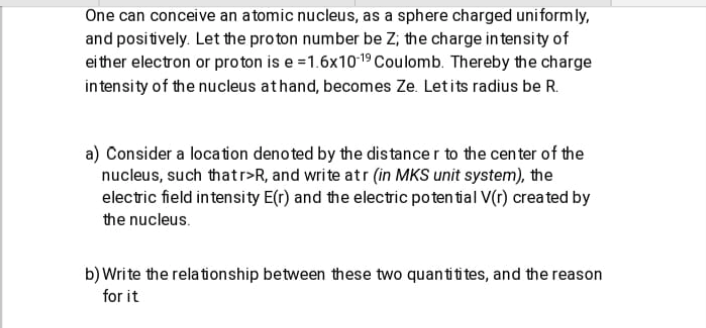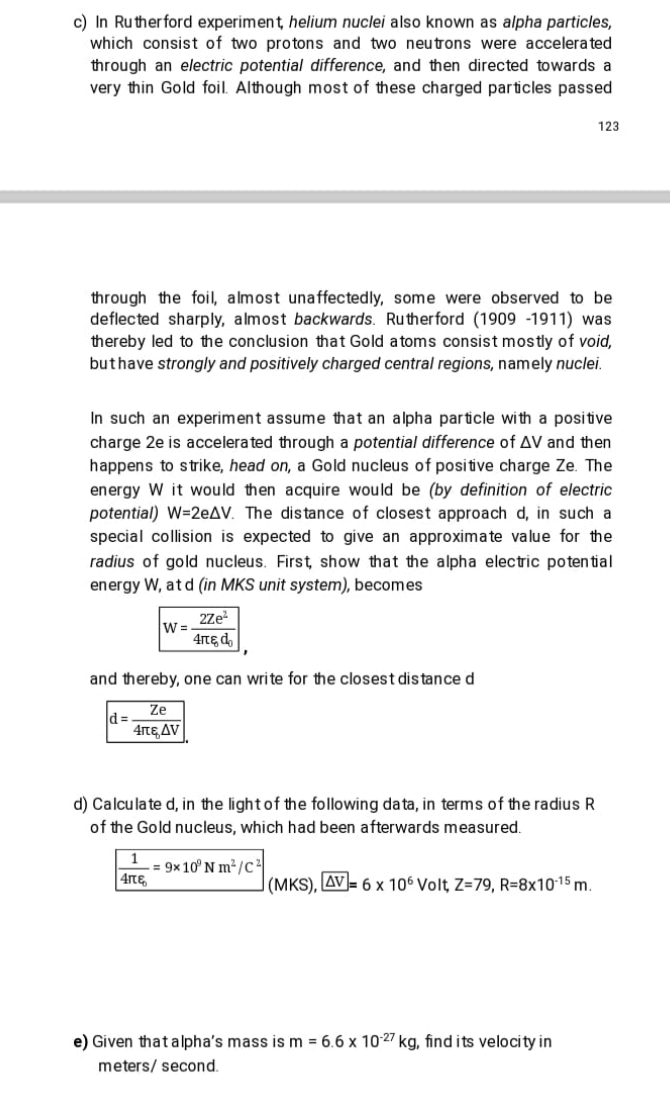One can conceive an atomic nucleus, as a sphere charged uniformly, and positively. Let the proton number be Z; the charge in tensity of ei ther electron or proton is e =1.6x1019Coulomb. Thereby the charge intensity of the nucleus athand, becomes Ze. Letits radius be R. a) Consider a location denoted by the dis tance r to the cen ter of the nucleus, such thatr>R, and wri te atr (in MKS unit system), the electric field intensity E(r) and the electric poten tial V(r) created by the nucleus.
One can conceive an atomic nucleus, as a sphere charged uniformly, and positively. Let the proton number be Z; the charge in tensity of ei ther electron or proton is e =1.6x1019Coulomb. Thereby the charge intensity of the nucleus athand, becomes Ze. Letits radius be R. a) Consider a location denoted by the dis tance r to the cen ter of the nucleus, such thatr>R, and wri te atr (in MKS unit system), the electric field intensity E(r) and the electric poten tial V(r) created by the nucleus.
Chapter6: Gauss's Law
Section: Chapter Questions
Problem 86AP: Two non-conducting spheres of radii R1 and R2 are uniformly charged with charge densities p1 and p2...
Related questions
Question
can you please help me ???

Transcribed Image Text:One can conceive an atomic nucleus, as a sphere charged uniformly,
and positively. Let the proton number be Z; the charge in tensity of
ei ther electron or proton is e =1.6x1019 Coulomb. Thereby the charge
in tensity of the nucleus athand, becomes Ze. Letits radius be R.
a) Consider a location denoted by the dis tance r to the center of the
nucleus, such thatr>R, and write atr (in MKS unit system), the
electric field intensity E(r) and the electric poten tial V(r) created by
the nucleus.
b) Write the rela tionship between these two quantiti tes, and the reason
for it

Transcribed Image Text:c) In Rutherford experiment, helium nuclei also known as alpha particles,
which consist of two protons and two neutrons were accelerated
through an electric potential difference, and then directed towards a
very thin Gold foil. Although most of these charged particles passed
123
through the foil, almost unaffectedly, some were observed to be
deflected sharply, almost backwards. Rutherford (1909 -1911) was
thereby led to the conclusion that Gold atoms consist mostly of void,
buthave strongly and positively charged central regions, namely nuclei.
In such an experiment assume that an alpha particle with a positive
charge 2e is accelerated through a potential difference of AV and then
happens to strike, head on, a Gold nucleus of positive charge Ze. The
energy W it would then acquire would be (by definition of electric
potential) W=2EAV. The distance of closest approach d, in such a
special collision is expected to give an approximate value for the
radius of gold nucleus. First, show that the alpha electric potential
energy W, atd (in MKS unit system), becomes
2ze?
W =
4rtg d,
and thereby, one can write for the closest dis tance d
Ze
d =
4πε Δν
d) Calculate d, in the lightof the following data, in terms of the radius R
of the Gold nucleus, which had been afterwards measured.
= 9x 10° N m² /C²
|4rte,
(MKS), AV= 6 x 106 Volt, Z=79, R=8x1015 m.
e) Given thatalpha's mass is m = 6.6 x 1027 kg, find its velocity in
meters/ second.
Expert Solution
This question has been solved!
Explore an expertly crafted, step-by-step solution for a thorough understanding of key concepts.
Step by step
Solved in 3 steps with 3 images

Knowledge Booster
Learn more about
Need a deep-dive on the concept behind this application? Look no further. Learn more about this topic, physics and related others by exploring similar questions and additional content below.Recommended textbooks for you

